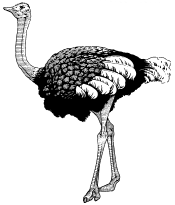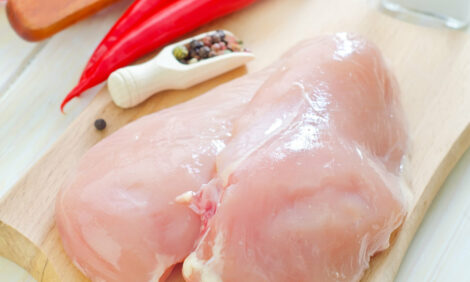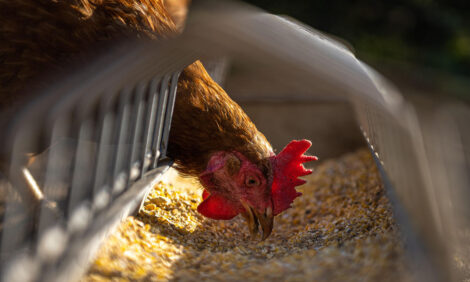



Biosecurity for Exotic Fowl
By Joan S. Jeffrey, Assistant Professor and Extension Poultry Veterinarian, The Texas A&M University System - Biosecurity is a practice designed to prevent the spread of disease into your farm. It is accomplished by maintaining the facility in such a way that there is minimal traffic of biological organisms (viruses, bacteria, rodents, etc.) across its borders. Biosecurity is the cheapest, most effective means of disease control available. No disease prevention program will work without it.What is biosecurity?
Biosecurity has three major components:
- Isolation
- Traffic control.
- Sanitation.
 Isolation refers to the confinement of animals
within a controlled environment. A fence keeps
your birds in, but it also keeps other
animals out. Isolation also applies
to the practice of separating
birds by age group. In
poultry operations, allin/
all-out management
styles allow
simultaneous depopulation
of facilities
between f locks and
allow time for periodic clean-up and
disinfection to break the cycle of
disease.
Isolation refers to the confinement of animals
within a controlled environment. A fence keeps
your birds in, but it also keeps other
animals out. Isolation also applies
to the practice of separating
birds by age group. In
poultry operations, allin/
all-out management
styles allow
simultaneous depopulation
of facilities
between f locks and
allow time for periodic clean-up and
disinfection to break the cycle of
disease.
Traffic control includes both the
traffic onto your farm and the
traffic patterns within the farm.
Sanitation addresses the disinfection
of materials and equipment
entering the farm and the cleanliness of the
personnel on the farm.
Infectious diseases can be spread from farm to
farm by:
- Introduction of diseased birds.
- Shoes and clothing of people who move from f lock to f lock.
- Introduction of healthy birds who have recovered from disease but are now carriers.
- Contact with inanimate objects (fomites) that are contaminated with disease organisms.
- Carcasses of dead birds that have not been disposed of properly.
- Impure water, such as surface drainage water.
- Rodents and free-f lying birds.
- Insects.
- Contaminated feed and feed bags.
- Contaminated premises through soil or old litter.
- Air-borne fomites.
- Egg transmission.
Of all of these factors, the introduction of new birds and traffic pose the greatest risk to bird health on exotic fowl farms. Properly managing these two factors should be a top priority on your farm.
How much biosecurity do I need?
In order to assess how much biosecurity is practical for your farm, look at these three factors.
- Economics.
- Common sense.
- Relative risk.
New birds represent a great risk to biosecurity
because their disease status is unknown. They
may have an infection or be susceptible to an
infection that is already present in birds that
appear normal (healthy carriers) on your farm.
While all-in/all-out management isn’t feasible
for most exotic fowl farms, it is possible for you to
maintain a separate pen or place to isolate and
quarantine all new, in-coming stock from the
resident population. Isolation pens should be
located as far away from the resident birds as
possible. At least 2 weeks of quarantine is suggested;
4 weeks is better.
Direct the f low of human traffic from youngest
birds to oldest birds. Direct the traffic f low from
the resident f lock to the isolation area. Use a
different pair of foot-covers in the isolation area
and in the resident bird area to prevent the
mechanical transfer of disease organisms on
footwear.
Footwear should be disinfected at each site.
Footbaths may help to decrease the dose of
organisms on boots. Wash your hands after
handling birds in isolation or birds of different
groups. Establish a “clear zone” free of vegetation
around buildings to discourage rodent and insect
traffic into the buildings. Plan periodic clean-out,
clean-up, and sanitation of facilities and equipment.
Disinfect waterers and feeders on a regular
basis. Remember that drying and sunlight are
very effective in killing many disease-causing
organisms.
How do I disinfect my premises?
To disinfect the premises of an exotic fowl farm, follow these steps. First, clean.
- Remove all bedding, feed, and manure.
- Sweep out loose dirt, cobwebs, etc.
- Scrub all surfaces with a detergent/disinfectant.
- Rinse all detergent and organic matter from
surfaces.
A steam or high-pressure water hose may be
helpful for steps 3 and 4.
Next, sanitize. - Apply the disinfectant.
- Allow the disinfectant to dry completely.
- Reapply the disinfectant and allow it to dry a second time (optional).
- Bed the area with fresh materials and rinse all water and feeding equipment before refilling them.
These steps are adapted from a procedure published in “Policies for Prevention,” Large Animal Veterinarian, May/June 1993.
How do I choose a disinfectant?
When choosing a disinfectant, consider these characteristics:
- Cost.
- Efficacy (killing efficiency against viruses, bacteria, fungi).
- Activity with organic matter.
- Toxicity (relative safety to animals).
- Residual activity.
- Effect on fabric and metals.
- Activity with soap.
- Solubility (acidity, alkalinity, pH).
- Contact time.
- Temperature.
- Phenols.
- Hypochlorites (chlorine).
- Iodophors (iodine).
- Quaternary ammonium.
- Formaldehyde gas.
- Formaldehyde powder.
- Alkali (lye).
- Chlorhexidine (Nolvasan).
The most commonly used disinfectants are the
phenols, iodophors, hypochlorites, and quaternary
ammonium.
 Phenols. Phenols are coal-tar derivatives. They
have a characteristic pine-tar odor and turn milky
in water. Phenols are effective antibacterial
agents, and they are also effective against fungi
and many viruses. They also retain more activity
in the presence of organic material that iodineor
chlorine-containing disinfectants. In commercial
poultry operations, phenols are used for egg
dipping, hatchery and equipment sanitation, and
footbaths. Examples of the phenol class include:
Lysol, Pine-Sol, Cresi-400, Environ, and Tek-Trol.
Phenols. Phenols are coal-tar derivatives. They
have a characteristic pine-tar odor and turn milky
in water. Phenols are effective antibacterial
agents, and they are also effective against fungi
and many viruses. They also retain more activity
in the presence of organic material that iodineor
chlorine-containing disinfectants. In commercial
poultry operations, phenols are used for egg
dipping, hatchery and equipment sanitation, and
footbaths. Examples of the phenol class include:
Lysol, Pine-Sol, Cresi-400, Environ, and Tek-Trol.
Iodophors. Iodine compounds are available as
iodophors, which are combinations of elemental
iodine and a substance that makes the iodine
soluble in water. They are good disinfectants, but
they do not work well in the presence of organic
material–that is, on dirty surfaces. Iodophors are
effective against bacteria, fungi, and many viruses.
In hatcheries, iodine is used on equipment
and walls and for water disinfection. Iodine is the
least toxic of the disinfectants discussed here, but
it can stain clothing and some surfaces. Examples
of the iodophor class include: Betadine, Iofec,
Isodyne, Losan, Tamed Iodine, and Weladol.
Hypochlorites. Chlorine compounds are good
disinfectants on clean surfaces, but they do not
work well on dirty surfaces. Chlorine is effective
against bacteria and many viruses. These compounds
are also much more active in warm water
than in cold water. Chlorine solutions are somewhat
irritating to skin and are corrosive to metal.
They are relatively inexpensive. Examples of the
hypochlorite class include: Clorox, Chloramine-T,
and Halazone.
Quaternary Ammonium. Quaternary ammonium
compounds are generally odorless, colorless,
non-irritating, and deodorizing. They also
have some detergent action, and they are good
disinfectants. However, they are inactivated in the
presence of some soaps or soap residues. Their
antibacterial activity is reduced in the presence of
organic material. Quaternary ammonium compounds
are effective against bacteria and somewhat
effective against fungi and viruses. These
compounds are used widely in commercial
hatcheries. Examples of the quaternary ammonium
class include: Roccal, Germex, Hi-Lethol,
San-O-Fec, Warden, and Zephiran.
For more information
For further information on disinfectants and
sanitizers, refer to the "Disinfectants for Swine
Herd Health Management" section of the
"County Swine Herd Health Guide," by Bruce
Lawhorn, Associate Professor and Extension
Swine Veterinarian. Your county Extension agent
has a copy of this guide, so contact the Extension
office for more information.
A more complete listing of commercial disinfectants
and sanitizers can be found in the article
“Guide to Health and Nutrition” published in
Pork, 1993, or the "1994 Buyers Guide"
published in Poultry Digest, December
1993, available for $6 per copy from Watt
Publishing Company (815-734-4171).
Source: Texas Cooperative Extension - July 2004









